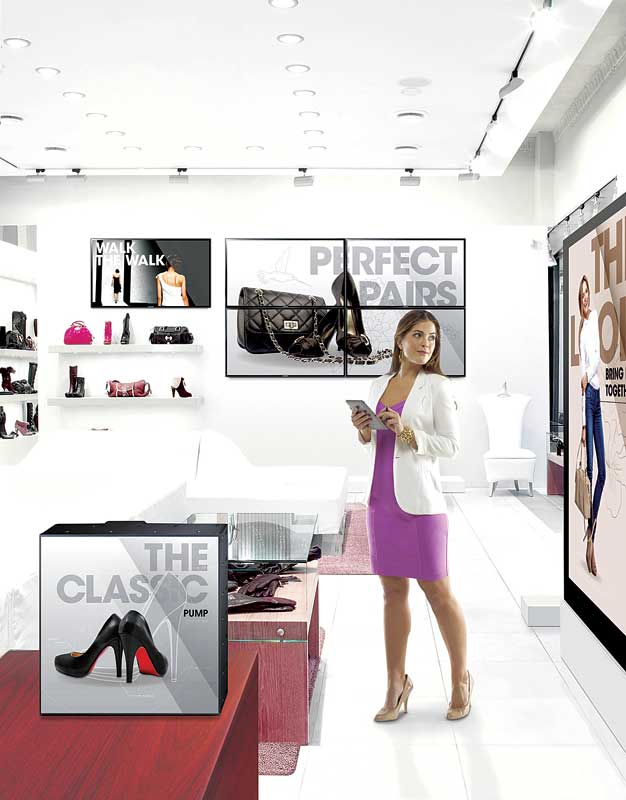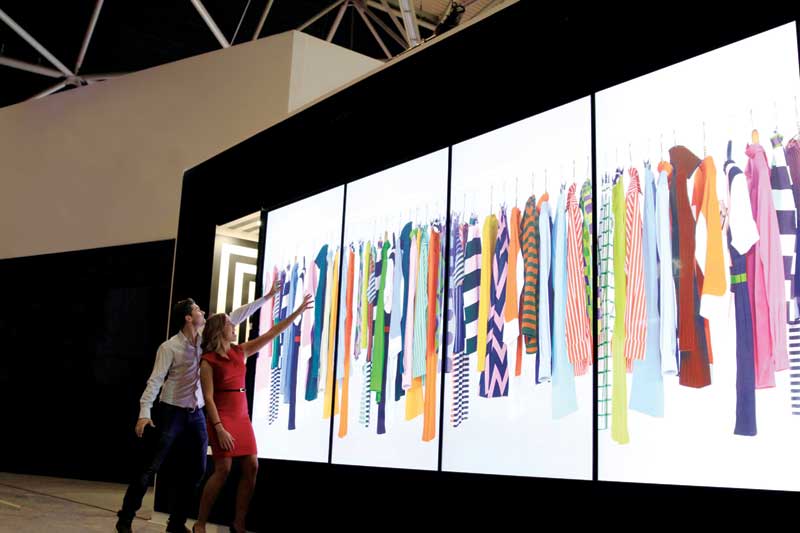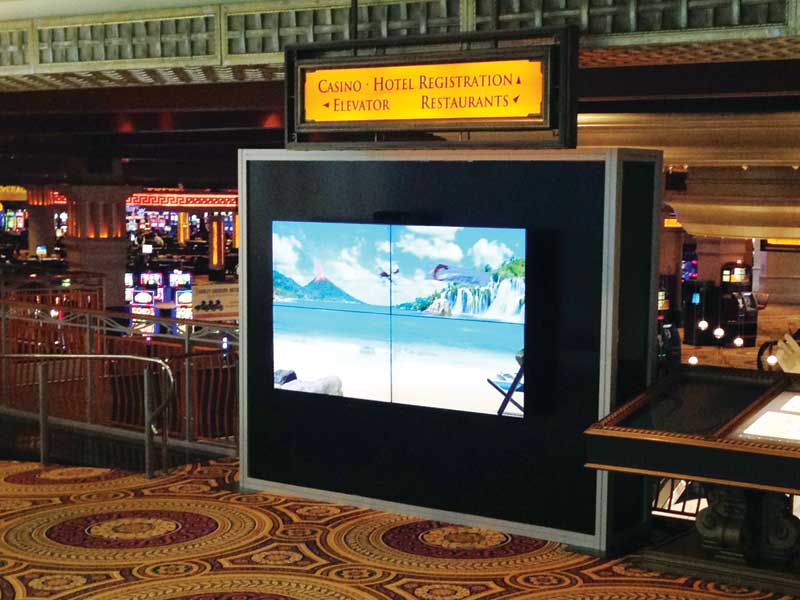Digital Signage: Tips for selecting displays
by all | 2 November 2016 10:36 am

Images courtesy Samsung
By Lyle Bunn
The flat-panel liquid crystal display (LCD) is a highly visible element of digital signage applications. During the specification and selection process, it becomes clear that many options are available in the market today. It is important to differentiate between panels for use in interior- and exterior-grade housing, based on some of the same principles that apply to light-emitting diodes (LEDs) for use in digital billboards and other large-format displays.
Digital signage customers tend not to get very excited about flat panel selection unless their deployment will be very large-scale or very high-profile, but the technology behind their displays is key to their networks’ success. Smaller system integrators, who are expected to provide trustworthy, fact-based objectivity, usually recommend products they are most familiar with, though they are advised to assess a wider range of models, given continuing advancements in technological features. Larger system providers and operators, meanwhile, operate their own labs as testing facilities to ensure the most suitable flat panel is selected for each customer’s purposes. This is the case with Stratacache, for example, which provides digital signage displays for clients like McDonald’s and Walmart.
The cost/benefit analysis
The lines appear to have been blurring between consumer- and commercial-grade LCDs, with descriptors like ‘prosumer’ or ‘light-duty commercial’ becoming increasingly common. This points to the need for a deeper assessment of available options, as the technology that lies ‘under the hood’ is what matters most to a cost/benefit analysis.
An LCD’s cost reflects its production, service and markup, while its benefits reflect its functionality and expected lifespan. When defining the relationship between cost and benefit, it is typical to hear the phrase ‘good enough.’ And too often, the selection decision is made with a bias toward a well-known brand name, an appealing appearance and a low cost.
While a display is indeed the most visible element of a digital signage system, the costs of flat panels have all declined over the years, to the point where they represent a minimal proportion of total system costs. Over the life of a network, certainly, content will far outweigh the costs of any other elements.

LCDs have become available in larger sizes over the years.
Photo courtesy LG Electronics
Further, a handful of manufacturers dominate the supply of commercial-grade LCDs for digital signage, with each offering a range of sizes and operating features, with a corresponding range of prices. Determining which best meets a project’s specification depends not only on size, but also on shape, bezel width, thickness, ease of installation, inputs, integrated processing, controls, viewing angles, warranty terms, energy conservation capabilities and long-term reliability.
CCFLs vs. LEDs
LCDs that are backlit with cold-cathode fluorescent lamps (CCFLs) are generally less expensive, thicker and heavier than those illuminated with LEDs. While CCFL LCDs have been the most widely used type for digital signage to date, some panel manufacturers are now discontinuing them in favour of the performance and energy efficiency of LED LCDs, which are lit either with a matrix of LEDs behind the screen or with an array of side-mounted LEDs.
LED LCDs are similar in many ways to CCFL LCDs, but offer a sharper, clearer image, brighter colours and improved contrast. They also reduce operating costs, as they consumer up to 50 per cent less power than CCFLs. The slimmer profile of LEDs is also beneficial, as some commercial LCDs are now just a few millimetres deep, compared to up to 127 mm (5 in.) for CCFL LCDs, and therefore can be installed in more locations with tighter tolerances. Both a narrow bezel and minimal depth will allow a display to seem ‘modern’ over a longer period of use.
Consumer vs. commercial
As for comparing a consumer-grade TV with a commercial-quality flat panel display, the decision should be easy. Consumer TVs are engineered for as little as two to four years of use, assuming three to four hours of viewing per day. Commercial-grade panels, on the other hand, are engineered for more than 60,000 duty hours.

EnVu and Calgary-based Carmanah Signs, both divisions of Stratacache, recently developed a responsive video wall for Caesars Windsor Casino in Windsor, Ont.
Photo courtesy Stratacache
It is common for digital signs to operate 18 hours a day, 365 days a year, which means they run 6,570 hours per year. This is why a commercial-grade display is so important, assuming the network is planned for an industry-average four- to eight-year lifespan.
Warranties reflect the difference, as they tend to be for one year for consumer TVs versus three to four years for digital signage displays. Further, consumer TVs are not designed to operate in portrait (vertical) mode, which has become popular for many digital signage applications, and they usually lack the controls and inputs necessary for optimizing display performance.
Some of the commercial-grade components designed to prolong the life of a display are those that ward off excessive heat, dust and humidity. A conformal coating, for example, is a thin polymer film or chemical coating that is applied to displays’ circuit boards to protect them against harsh environmental factors. Once applied, the coating conforms to the circuit assembly to keep water vapour and solid debris out.
Both commercial-grade components and LEDs can be effectively cooled by convection, negating the need for supplemental fan-based cooling. Convection has several advantages over fans, as it reduces noise, consumes less electricity and pulls less contaminated air into the workings of the display.
The International Electrotechnical Commission (IEC) has developed ingress protection (IP) ratings to define the degree to which a specific enclosure keeps dust and moisture out. An IP5X certification, for example, means a display has passed rigorous tests to ensure it is dustproof.

Content may need to be clearly visible across a wide viewing angle without distortion or haze.
Image courtesy Samsung
Supporting content
The display and the content it presents could be said to be ‘joined at the hip.’ The warmth, hue and visual appeal of content can vary from screen to screen. This is most obvious when comparing a strong brand colour—e.g. red—on two displays side-by-side. Brightness, resolution, contrast ratio, refresh rate and colour accuracy are all worthy of attention during selection.
Beyond appearance, though, much of the technology ‘under the hood’ has a significant impact on how content will play out. With respect to connectivity, for example, some manufacturers now embed the media player—i.e. the compact personal computer (PC) dedicated to content playback—within the panel, but most networks use external media players instead to take better advantage of a more diverse range of content management software. To cross the distance between a panel and an external media player, connections may use proximity cabling via Digital Video Interface (DVI), High-Definition Multimedia Interface (HDMI) or DisplayPort (DP) technology or a transmitter and receiver for wireless signals.
Connectivity of the panel to content management software is also important for reporting performance, as is ‘failover’ functionality to ensure content is displayed from internal memory without interruption when an external input is not working.
“Effective management capabilities are a vital consideration when choosing a digital signage display,” says Dan Smith, director of digital signage for LG Electronics. “Simple Network Management Protocol (SNMP) standards allow system integrators to communicate remotely with screens for more efficient troubleshooting, reducing staff time and resources spent monitoring and maintaining the displays. A panel-facing pixel sensor, for example, provides the ability to monitor the front of the display continuously, even if the backlighting is powered down. Wireless-fidelity (Wi-Fi), hardwiring and failover options for failed image inputs ensure content is always running seamlessly.”
Other functions that add value include automatic brightness adjustment to ambient light conditions, ‘screen wash’ to prevent phantom images from burning in and user lockout to prevent content hacking.

Some manufacturers now embed media players within their LCD panels.
Image courtesy Advantech
Viewing angles
While most flat panel manufacturers claim to provide a nearly 180-degree viewing angle, a screen’s image quality off the perpendicular viewing axis and at wide angles can erode quickly. The real issue, when selecting a display, is the degree to which content is easily viewable from a wider horizontal or vertical angle without the degradation of colour accuracy and brightness.
Off-axis viewing is a common requirement for displays mounted along walkways, beside drive-thru lanes, near customer service counters and in exhibits. As such, content needs to be clearly visible without distortion or haze from a wide viewing angle. The use of an anti-reflection coating or of anti-glare glass, in particular, can improve image quality and ease of viewing for these situations.
Selecting a supplier
Flat-panel LCDs may be purchased from (a) original equipment manufacturers (OEMs), (b) specialized firms that source key components from OEMs, (c) distributors or (d) resellers. In any case, the integrator will benefit from sourcing screens from a provider with a long track record and solid depth of experience with digital signage applications. Also, the supplier should be ‘healthy’ from a corporate standpoint to ensure they will still be around to honour warranties and upgrade devices should the need arise in the future.
It is important to keep in mind how sales representatives’ recommendations may be influenced by inventory levels, special promotions and commission structures. At the same time, integrators should be open to options that seem more expensive initially, but promise a lower total cost of ownership (TCO) and better performance over the expected four to eight years of operations.
Ultimately, flat panel selection for digital signage comes down to the question of which model will best showcase the planned content at the lowest cost over its length of use. Answering this question requires supplier and buyer to assess a range of options, set aside their biases and make a decision based on facts.
Lyle Bunn is an independent digital signage industry analyst, advisor and educator based in Brighton, Ont. For more information, contact him via e-mail at lyle@lylebunn.com[1].
- lyle@lylebunn.com: mailto:lyle@lylebunn.com
Source URL: https://www.signmedia.ca/digital-signage-tips-for-selecting-displays/